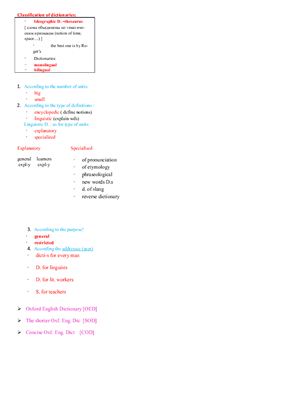Lexicology english department 3d year
Examination Questions
Lexicology as a branch of linguistics. Relations between lexicology and other aspects of linguistics. The sections of lexicology.
Lexicography as a part of lexicology. Different problems of dictionary making.
Classifications of dictionaries.
Word meaning principal approaches. Types of meaning.
The structure of lexical meaning of a word. The problem of connotation.
Meaning and polysemy. Semantic structure of the word.
Word meaning and meaning in morphemes.
Word meaning and motivation.
Change of meaning. Nature of semantic change.
The nominative aspect of meaning.
Semantic classification of lexical units. Synonyms. Classification of synonyms.
Homonyms. Classification of homonyms.
Semantic classification of lexical units. Antonyms. Classification of antonyms.
Phraseology. Free collocations versus phraseological units.
The development of a phraseological unit. The classification of phraseological units.
Morphemic structure of a word.
Word-structure. The levels of approach to the study of word-structure.
Types of morphemes. 19.1С and UC analysis.
Ways of word-formation in Mode English.
Affixation as a way of word-formation.
Suffixation.
Prefixation.
Conversion.
Compounding. Criteria of compounds.
Principles of classification of compounds.
Shortening, blending, back-formation, sound-and-stress interchange as ways of word-formation.
Borrowings in the English language versus native words.
Assimilation of borrowings.
Methods of linguistic analysis.
Examination Questions
Lexicology as a branch of linguistics. Relations between lexicology and other aspects of linguistics. The sections of lexicology.
Lexicography as a part of lexicology. Different problems of dictionary making.
Classifications of dictionaries.
Word meaning principal approaches. Types of meaning.
The structure of lexical meaning of a word. The problem of connotation.
Meaning and polysemy. Semantic structure of the word.
Word meaning and meaning in morphemes.
Word meaning and motivation.
Change of meaning. Nature of semantic change.
The nominative aspect of meaning.
Semantic classification of lexical units. Synonyms. Classification of synonyms.
Homonyms. Classification of homonyms.
Semantic classification of lexical units. Antonyms. Classification of antonyms.
Phraseology. Free collocations versus phraseological units.
The development of a phraseological unit. The classification of phraseological units.
Morphemic structure of a word.
Word-structure. The levels of approach to the study of word-structure.
Types of morphemes. 19.1С and UC analysis.
Ways of word-formation in Mode English.
Affixation as a way of word-formation.
Suffixation.
Prefixation.
Conversion.
Compounding. Criteria of compounds.
Principles of classification of compounds.
Shortening, blending, back-formation, sound-and-stress interchange as ways of word-formation.
Borrowings in the English language versus native words.
Assimilation of borrowings.
Methods of linguistic analysis.

